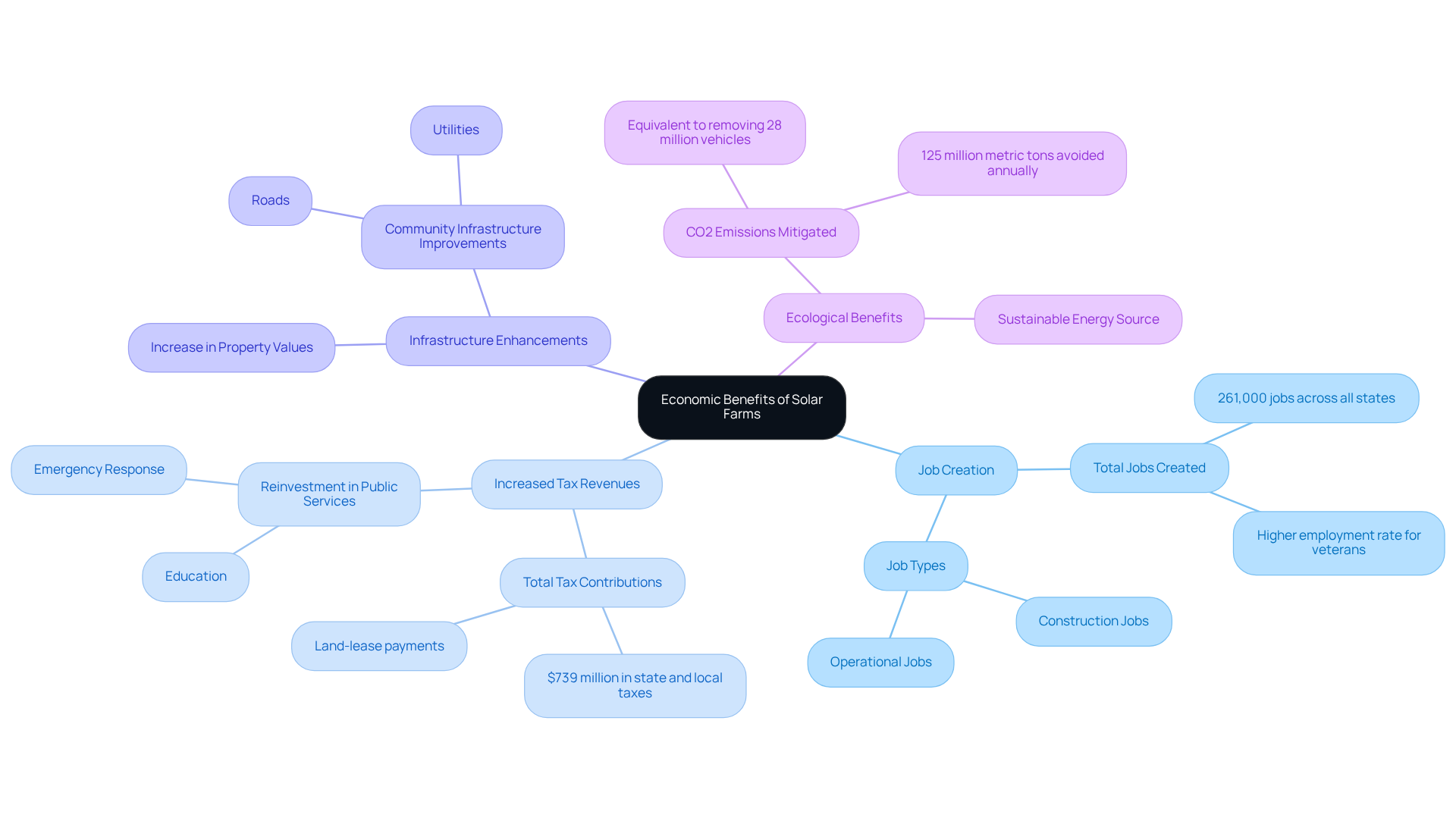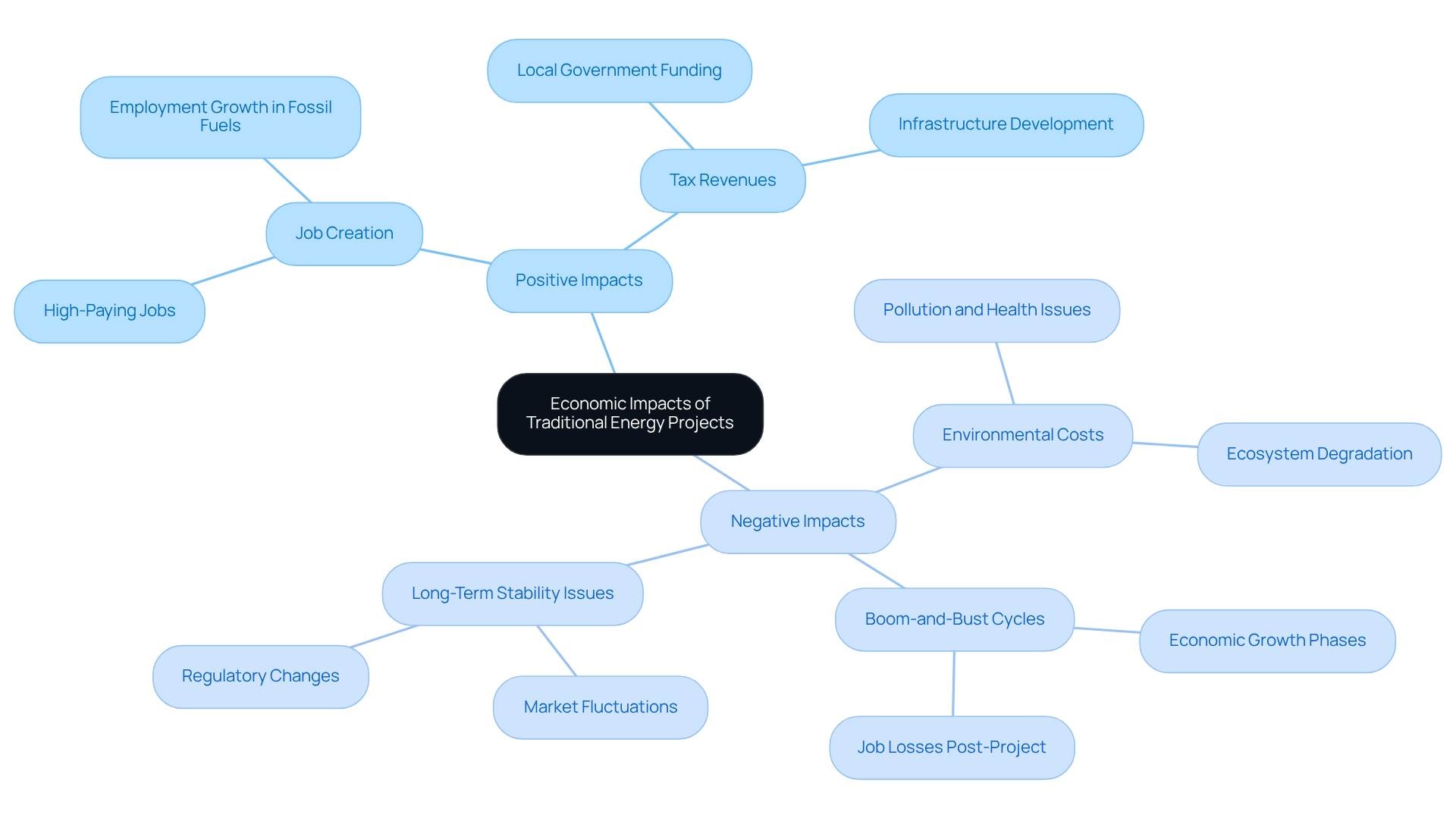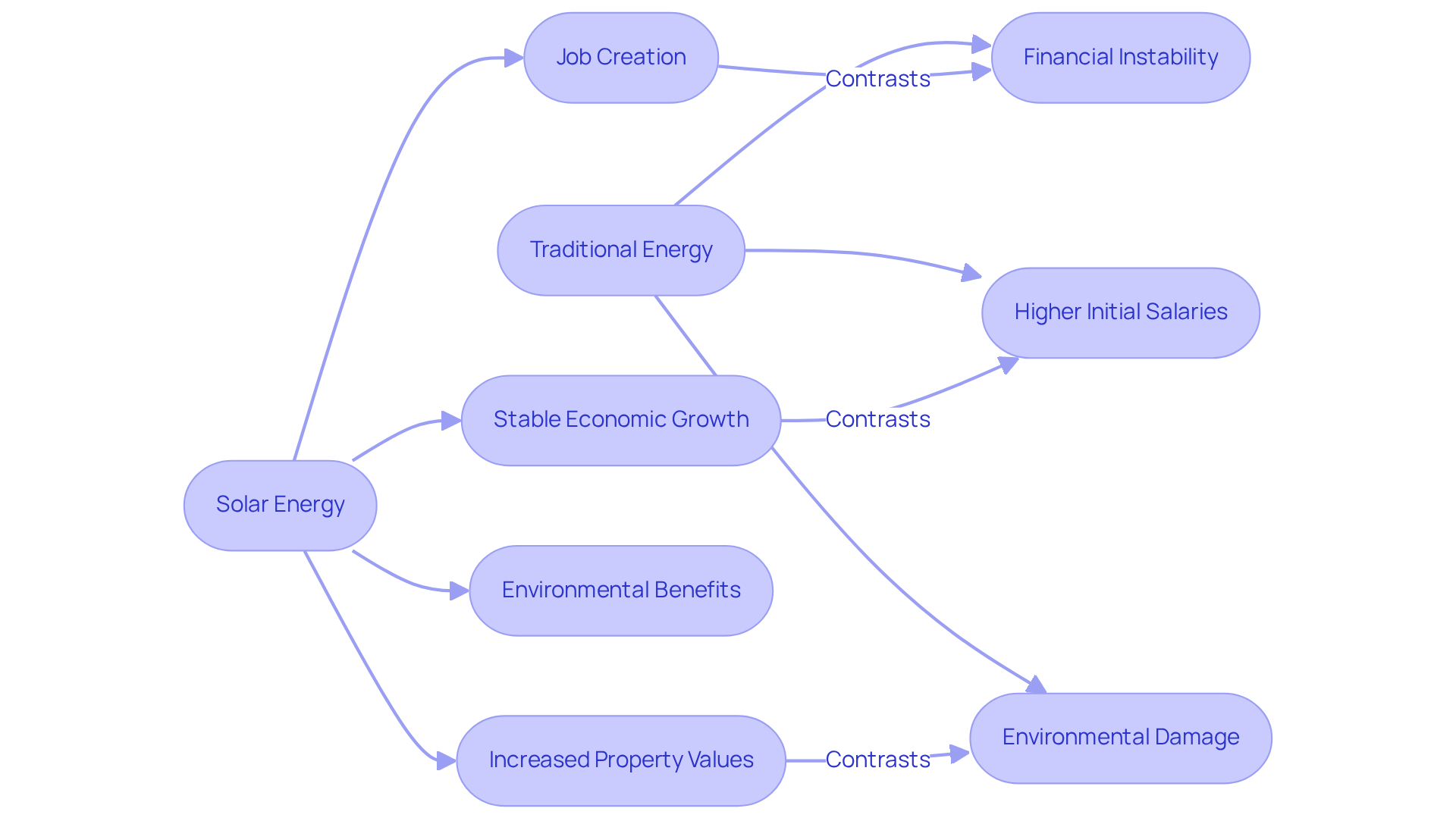Overview
The local economic impacts of solar farms stand out as significantly more favorable than those of traditional energy projects. Solar farms not only provide stable job creation but also lead to increased tax revenues and infrastructure improvements, all while minimizing environmental harm. This article underscores these advantages by detailing how solar farms generate diverse employment opportunities and enhance property values.
In contrast, conventional energy initiatives often result in economic instability and environmental degradation, highlighting the pressing need for a shift towards renewable energy solutions.
Introduction
The transition to renewable energy sources has ignited a significant debate regarding their economic implications, especially when juxtaposing solar farms with traditional energy projects. Solar farms present numerous advantages for local communities, including:
- Job creation
- Increased tax revenues
- Infrastructure enhancements that collectively elevate quality of life
Conversely, the appeal of fossil fuel initiatives, often associated with high-paying job opportunities, raises critical questions about:
- Long-term sustainability
- Environmental repercussions
How do these opposing energy sources genuinely affect local economies? Which path promises a more stable and prosperous future for communities?
Economic Benefits of Solar Farms for Local Communities
The local economic impacts of solar farms provide substantial advantages to surrounding communities, chiefly through job creation, increased tax revenues, and infrastructure enhancements. Utility-scale renewable energy projects can generate thousands of jobs during both construction and operational phases, showcasing the local economic impacts of solar farms on regional employment rates. For instance, the renewable energy sector has produced nearly 261,000 jobs across all 50 states, employing veterans at a higher rate than the national average, reflecting a commitment to workforce diversity and skill utilization.
Moreover, these initiatives bolster the tax base, illustrating the local economic impacts of solar farms, with renewable energy efforts contributing $739 million in state and municipal taxes and land-lease payments last year. The total investment in renewable energy initiatives throughout the United States has approached nearly $195 billion, underscoring the considerable financial impact of the energy sector. This revenue can be reinvested into vital public services, including education and emergency response.
Additionally, photovoltaic farms often facilitate improvements to community infrastructure, such as roads and utilities, which can enhance the local economic impacts of solar farms. Research shows that communities hosting photovoltaic farms frequently experience an increase in property values, as renewable energy sources are increasingly viewed as desirable features in real estate.
Furthermore, the CO2 emissions mitigated by large-scale renewable energy systems are comparable to removing 28 million vehicles from the roads, highlighting the ecological benefits alongside the economic gains. Overall, the local economic impacts of solar farms are diverse and significant, providing a robust foundation for regional economies to prosper.

Economic Impacts of Traditional Energy Projects
Conventional energy initiatives, such as coal, natural gas, and oil, have historically played a pivotal role in supporting regional economies through job creation and tax revenues. However, the impacts of these initiatives can vary significantly. For example, while fossil fuel initiatives can generate high-paying employment opportunities, they often come with substantial environmental costs that adversely affect local communities. Furthermore, reliance on non-renewable resources can lead to boom-and-bust cycles, where communities experience economic growth during development phases but subsequently face job losses and financial decline once these initiatives are completed or shut down.
Moreover, conventional energy initiatives may lack the long-term financial stability that renewable energy initiatives can provide, as they are subject to market fluctuations and regulatory changes. The environmental degradation associated with fossil fuel extraction can lead to increased healthcare costs and a diminished quality of life for nearby residents. Ultimately, these factors can undermine the financial advantages that these initiatives might initially present.

Comparative Analysis of Local Economic Impacts: Solar vs. Traditional Energy
When evaluating the local economic impacts of solar farms compared to conventional energy initiatives, significant distinctions emerge. The local economic impacts of solar farms include providing stable and sustainable economic benefits over the long term. They generate a diverse array of jobs, spanning construction to maintenance, and frequently contribute to the local economic impacts of solar farms through ongoing revenue from land leases and tax contributions.
As of 2023, the renewable energy workforce boasts over 69,000 women, reflecting a 39% increase in female employment since 2015. This growth is part of a broader trend, with renewable energy jobs totaling 279,447 positions in the U.S., indicating a 5.9% increase from the previous year and a recovery from substantial job losses during the pandemic.
In contrast, conventional energy initiatives may yield higher initial salaries but often lead to financial instability due to their cyclical nature. Furthermore, photovoltaic farms enhance property values and regional infrastructure, which illustrates the local economic impacts of solar farms, whereas conventional energy initiatives can sometimes inflict environmental damage, negatively impacting community health and property values.
Renewable energy initiatives are increasingly recognized as a means to promote energy autonomy and resilience, further bolstering community financial stability. Gabrielle Giffords has underscored the transformative potential of sunlight-derived energy on the economy and living expenses, highlighting its financial viability.
In summary, while both energy sources contribute to local economies, the local economic impacts of solar farms show that they emerge as a more sustainable and community-oriented option, particularly concerning long-term economic planning and environmental stewardship.

Conclusion
The analysis of local economic impacts reveals that solar farms present a compelling alternative to traditional energy projects, offering sustainable benefits that extend beyond immediate financial gains. Unlike conventional energy initiatives, which often lead to boom-and-bust cycles and environmental degradation, solar farms provide a stable and long-term economic solution for communities. They promote job creation and enhance local infrastructure.
Key insights illustrate the multifaceted advantages of solar energy projects. These include:
- Significant job creation
- Increased tax revenues
- Improvements in community infrastructure
The renewable energy sector not only employs a diverse workforce but also contributes substantially to local economies through land-lease payments and tax contributions. In contrast, traditional energy projects, while potentially lucrative in the short term, often result in environmental and health challenges that can diminish long-term economic stability.
Reflecting on these findings underscores the importance of prioritizing renewable energy initiatives to foster resilient and thriving local economies. As communities continue to seek sustainable development pathways, the adoption of solar energy projects stands out as a viable strategy. It addresses immediate economic needs while promoting environmental stewardship and community well-being. Embracing this transition can lead to a brighter, more sustainable future for all.
Frequently Asked Questions
What are the economic benefits of solar farms for local communities?
Solar farms provide substantial economic benefits to local communities through job creation, increased tax revenues, and infrastructure enhancements.
How many jobs do solar farms create?
Utility-scale renewable energy projects can generate thousands of jobs during both the construction and operational phases. The renewable energy sector has produced nearly 261,000 jobs across all 50 states.
Do solar farms employ veterans?
Yes, the renewable energy sector employs veterans at a higher rate than the national average, reflecting a commitment to workforce diversity and skill utilization.
How do solar farms impact local tax revenues?
Renewable energy initiatives contribute significantly to the tax base, with solar farms generating $739 million in state and municipal taxes and land-lease payments last year.
What is the total investment in renewable energy initiatives in the United States?
The total investment in renewable energy initiatives throughout the United States has approached nearly $195 billion.
How does the revenue from solar farms benefit local communities?
The revenue generated from solar farms can be reinvested into vital public services, including education and emergency response.
What infrastructure improvements are associated with solar farms?
Photovoltaic farms often facilitate improvements to community infrastructure, such as roads and utilities, which can enhance local economies.
How do solar farms affect property values?
Communities hosting photovoltaic farms frequently experience an increase in property values, as renewable energy sources are increasingly viewed as desirable features in real estate.
What ecological benefits do solar farms provide?
The CO2 emissions mitigated by large-scale renewable energy systems are comparable to removing 28 million vehicles from the roads, highlighting significant ecological benefits alongside economic gains.
How do solar farms contribute to the prosperity of regional economies?
Overall, the local economic impacts of solar farms are diverse and significant, providing a robust foundation for regional economies to prosper.
List of Sources
- Economic Benefits of Solar Farms for Local Communities
- New Report from UIL Analyzes the Potential Economic Impact of Community Solar for the State of Washington (https://uil.be.uw.edu/2025/01/07/new-report-from-uil-analyzes-the-economic-impact-of-community-solar-programs-for-the-state-of-washington)
- Utility-Scale Solar Power Facts | ACP (https://cleanpower.org/facts/solar-power)
- Economic Impacts of Traditional Energy Projects
- Executive summary – World Energy Employment 2024 – Analysis - IEA (https://iea.org/reports/world-energy-employment-2024/executive-summary)
- Quotes About Solar Power: 50 Picks to Light Up Your Life - Lumify Energy (https://lumifyenergy.com/blog/quotes-about-solar-power)
- What High-Quality Local Jobs Are Available as Fossil Fuel Work Disappears? (https://workrisenetwork.org/working-knowledge/what-high-quality-local-jobs-are-available-fossil-fuel-work-disappears)
- 60 Quotes About the Future of Renewable Energy (https://deliberatedirections.com/renewable-energy-quotes)
- Trump Administration’s 2025 Energy Policy Roundup Part 1: Fueling a Fossil Future - Lewis Brisbois Bisgaard & Smith LLP (https://lewisbrisbois.com/newsroom/legal-alerts/trump-administrations-2025-energy-policy-roundup-part-1-fueling-a-fossil)
- Comparative Analysis of Local Economic Impacts: Solar vs. Traditional Energy
- (PDF) Cultures of Community Energy: International Case Studies (https://researchgate.net/publication/303684332_Cultures_of_Community_Energy_International_Case_Studies)
- Quotes About Solar Power: 50 Picks to Light Up Your Life - Lumify Energy (https://lumifyenergy.com/blog/quotes-about-solar-power)
- National Solar Jobs Census 2020 – SEIA (https://seia.org/research-resources/national-solar-jobs-census-2020)
- Census Solar Job Trends (https://irecusa.org/census-solar-job-trends)




